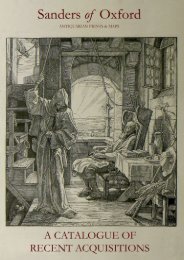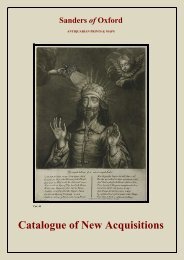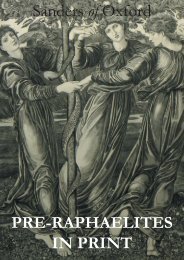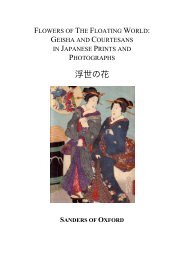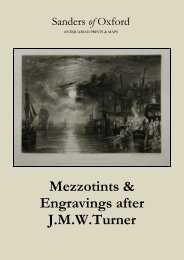Sanders of Oxford - Japanese Woodblock Prints
Sanders of Oxford - Japanese Woodblock Prints
Sanders of Oxford - Japanese Woodblock Prints
You also want an ePaper? Increase the reach of your titles
YUMPU automatically turns print PDFs into web optimized ePapers that Google loves.
Bijin-ga<br />
1. Beauties with Umbrella by the Shrine Gate<br />
<strong>Woodblock</strong> print (nishiki-e)<br />
Shoda Koho (1871-1946)<br />
c. 1910<br />
Tanzaku [3 x 13.75 inches]<br />
Vertical, narrow prints are a by-product <strong>of</strong><br />
traditional <strong>Japanese</strong> architecture, which <strong>of</strong>fered<br />
very few solid wall surfaces. Many times, the only<br />
solid surface available for the hanging <strong>of</strong> pictures,<br />
were the structural posts which held up the ro<strong>of</strong>.<br />
"Pillar prints" became a genre unto themselves<br />
and were referred to in <strong>Japanese</strong> as hashira-e or<br />
tanzaku.<br />
[29620]<br />
£140<br />
2. Beauty in a Tea Booth<br />
<strong>Woodblock</strong> print<br />
Shoda Koho (1871-1946)<br />
c. 1910<br />
Tanzaku [3 x 13.75 inches]<br />
The design <strong>of</strong> pleasing compositions within such a<br />
constrained format is a serious challenge for the<br />
artist. Yoshimoto Gesso and Shoda Koho, the<br />
artists who designed the prints in this series, have<br />
certainly risen to this challenge and produced a<br />
wide variety <strong>of</strong> wonderful designs.<br />
This series was listed simply as 1 line item in the<br />
Hasegawa / Nishinomiya catalogue. The<br />
implication is that there were 96 separate images<br />
available. They were sold as sets <strong>of</strong> 12 prints.<br />
[29612]<br />
£140
Kabuki<br />
Kacho-e<br />
3. Kabuki Actor with a sword in a Boat<br />
<strong>Woodblock</strong> print<br />
Shunkosai Hokuei<br />
c. 1835<br />
Ôban tate-e [sheet 14 x 9 1/2 inches]<br />
Shunbaisai Hokuei (active (824-1837) also known<br />
as Shunko- III, was a designer <strong>of</strong> ukiyo-e style<br />
<strong>Japanese</strong> woodblock prints in Osaka. He was a<br />
student <strong>of</strong> Shunko-sai Hokushu-. Hokuei’s prints<br />
most <strong>of</strong>ten portray the kabuki actor Arashi Rikan II.<br />
[29566]<br />
£200<br />
4. Blue Bird on an Autumn Branch<br />
<strong>Woodblock</strong><br />
Gyosui Kawanabe (1868-1935)<br />
c. 1950<br />
Image and sheet 243 x 124 mm<br />
Gyosui was one <strong>of</strong> the few famous female artists<br />
before the Shin Hanga movement. She taught<br />
Nihon-ga, <strong>Japanese</strong> traditional painting, at Joshibi<br />
University <strong>of</strong> Arts and Crafts. She was the<br />
daughter <strong>of</strong> Kyosai Kawanabe.<br />
[29633]<br />
£150
5. Robber Fly on Snake Gourd<br />
<strong>Woodblock</strong><br />
Gyosui Kawanabe (1868-1935)<br />
c. 1950<br />
Image and sheet 243 x 124 mm<br />
Gyosui was one <strong>of</strong> the few famous female artists<br />
before the Shin Hanga movement. She taught<br />
Nihon-ga, <strong>Japanese</strong> traditional painting, at Joshibi<br />
University <strong>of</strong> Arts and Crafts. She was the<br />
daughter <strong>of</strong> Kyosai Kawanabe.<br />
[29632]<br />
£150<br />
6. [Blue Bird and Magnolia]<br />
<strong>Woodblock</strong> print (nishiki-e)<br />
Ohara Koson [Shoson; Hoson] (1877-1945)<br />
c. 1930<br />
tanzaku [7.5 x 14 inches]<br />
Signature: Koson.<br />
Seal: Artist's seal ('Koson')<br />
Ohara Koson [Shoson; Hoson] (1877-1945) was<br />
born in Kanazawa in Ishikawa Prefecture in the<br />
North <strong>of</strong> Japan with the given name Ohara Matao.<br />
He had studied painting as a student <strong>of</strong> Suzuki<br />
Koson, whose name he adopted as his artist go.<br />
During his career he changed his name to Shoson<br />
and Hoson. He is best known for kacho-e or<br />
wildlife prints and they were exported in large<br />
numbers to the United States.<br />
References: Amy Reigle Newland, Jan Perree, and Robert Schaap,<br />
‘Crows, Cranes, and Camellias’ (Leiden: Hotei Publishing, 2001). Hiraki<br />
Ukiyo-e Museum,‘Ohara Koson: Artist <strong>of</strong> Kacho-ga, <strong>Prints</strong> <strong>of</strong> Birds and<br />
Flowers’ (Hiraki Ukiyo-e Museum,1998).<br />
[29621]<br />
£550
7. Rabbit<br />
<strong>Woodblock</strong><br />
Ogata Gekko (1859-1920)<br />
c. 1910<br />
Shikishiban 243 x 250 mm<br />
Siganture: Gekko with artist’s seal<br />
Comments: Early impression.<br />
Considered an early modernist by some critics,<br />
Ogata Gekkô, together with Tsukioka Yoshitoshi<br />
(1839-92) and Shibata Zeshin (1807-91), was one<br />
<strong>of</strong> the most important artists <strong>of</strong> the Meiji (1868-<br />
1912) and Taïshô (1912-26) periods. Like<br />
Yoshitoshi and Zesshin, he was known for a style<br />
<strong>of</strong> printmaking that was highly innovative in both<br />
iconographical and technical terms.Born in 1859,<br />
in the district <strong>of</strong> Kyôbashi in Edo (modern Tôkyô),<br />
he was later adopted by the Ogata family. As a<br />
self-taught painter, unaffiliated to any ukiyo-e<br />
studio from which he could claim appellative<br />
allegiance, he retained their name as an artistic<br />
nom-de-plume. This lack <strong>of</strong> formal training,<br />
particularly within the rigid hierarchy <strong>of</strong> an atelier,<br />
seems to have given his work a freshness and<br />
originality lacking in many <strong>of</strong> his contemporaries'<br />
oeuvres. Free from the constriction <strong>of</strong> following<br />
the codified visuality <strong>of</strong> one school, his woodblocks<br />
are redolent <strong>of</strong> a variety <strong>of</strong> influences, including<br />
Kano Tan'yû (1602-74), Tani Bunchô (1763-1840),<br />
Maruyama Ôkyo (1733-95) and Kikuchi Yôsaï<br />
(1788-1878). Ôkyo, an artistic innovator fascinated<br />
by perspective and the presentation <strong>of</strong> reality<br />
within European art, seems to have been<br />
particularly influential figure- Gekko's work clearly<br />
demonstrating a similarly powerful interest in the<br />
techniques <strong>of</strong> Occidental art, the adoption <strong>of</strong> which<br />
facilitated his desire to extend the boundaries <strong>of</strong><br />
traditional <strong>Japanese</strong> art. In formal terms, Gekko's<br />
work is characterised by his attempts to emulate<br />
painterly aesthetics within a woodblock idiom. This<br />
is particularly evident in the finer details <strong>of</strong> his<br />
images, which closely resemble the feathery brush<br />
strokes <strong>of</strong> his numerous paintings. While Gekko's<br />
subject matter varied considerably - ranging from<br />
kacho-e (bird and flower prints) to wildlyimaginative<br />
mythological studies - his ability to<br />
convey narrative without compromising<br />
compositional impact seems to have been derived<br />
from his journalistic work for papers such as the<br />
Asahi Shinbun. In late nineteenth-century Japan,<br />
daily and weekly newspapers and journals were<br />
springing up in every urban centre and pictorial<br />
supplements were instrumental to their popularity.<br />
The 1894-5 Sino-<strong>Japanese</strong> conflict, for example,<br />
spawned a vast number <strong>of</strong> woodblock prints. Some<br />
artists, including Gekkô, actually accompanied<br />
troops in the field, making rapid sketches which<br />
could then be quickly worked up as spectacular<br />
scenes for the <strong>Japanese</strong> and, as the United States<br />
was part-financing the war, American public. An<br />
artist increasingly feted by the establishment,<br />
Gekkô exhibited his works not only within a<br />
number <strong>of</strong> prestigious <strong>Japanese</strong> exhibitions, but<br />
also as part <strong>of</strong> the national display at various world<br />
fairs, including Chicago (1893), Paris (1900) and<br />
London (1910). He also played an important role in<br />
the development <strong>of</strong> several artists' associations, in<br />
particular Nihon Bijutsu Kyôkaï, Nihon Seinen<br />
Kaïga Kyôkaï, the Academy <strong>of</strong> <strong>Japanese</strong> art, and<br />
Bunten. During the latter years <strong>of</strong> his career, his<br />
images also started entering the collections <strong>of</strong> the<br />
Imperial house and the Crown prince.<br />
[29638]<br />
£350
8. Crow and Cherry Blossoms<br />
<strong>Woodblock</strong><br />
Ohara Koson [Shoson; Hoson] (1877-1945)<br />
n.d. c. 1910<br />
Seal: Artist’s seal Koson<br />
Publisher: Daikokuya.<br />
Ohara Koson [Shoson; Hoson] (1877-1945) was<br />
born in Kanazawa in Ishikawa Prefecture in the<br />
North <strong>of</strong> Japan with the given name Ohara Matao.<br />
He had studied painting as a student <strong>of</strong> Suzuki<br />
Koson. He is best known for his kacho-e or wildlife<br />
prints, <strong>of</strong> which his designs were produced in<br />
prolific numbers for a primarily Western market<br />
and range from images <strong>of</strong> haunting realism to<br />
humorous depictions <strong>of</strong> animals at play.<br />
Refrence: Newland, Amy R.; Jan Perrée & Robert Schaap, "Crows,<br />
cranes & camellias: The Natural World <strong>of</strong> Ohara Koson", Leiden: Hotei<br />
Publishing, 2001, ISBN 90-74822-38-x, - pg. 70. Pl.46.<br />
Condition: Excellent. Full sheet with margins<br />
[29508]<br />
£850<br />
9. Monkey in Persimmon Tree<br />
<strong>Woodblock</strong><br />
Ohara Koson [Shoson; Hoson] (1877-1945)<br />
n.d. c. 1930<br />
Tanzaku [7.5 x 14 inches], 344 x 186 mm<br />
Signature: Koson<br />
Publisher: Kokkeido<br />
Ohara Koson [Shoson; Hoson] (1877-1945) was<br />
born in Kanazawa in Ishikawa Prefecture in the<br />
North <strong>of</strong> Japan with the given name Ohara Matao.<br />
He had studied painting as a student <strong>of</strong> Suzuki<br />
Koson. He is best known for his kacho-e or wildlife<br />
prints, <strong>of</strong> which his designs were produced in<br />
prolific numbers for a primarily Western market<br />
and range from images <strong>of</strong> haunting realism to<br />
humorous depictions <strong>of</strong> animals at play.<br />
Condition: Excellent. Full sheet with margins<br />
[29507]<br />
£1,200
10. Two Crows in flight next to snow-covered<br />
willow branches, an orange sky behind<br />
<strong>Woodblock</strong> print (nishiki-e)<br />
Ohara Koson [Shoson; Hoson] (1877-1945)<br />
c. 1910’s<br />
tanzaku [7.5 x 14 inches]<br />
Signature: Koson<br />
Seal: Kokkeido<br />
Ohara Koson [Shoson; Hoson] (1877-1945) was<br />
born in Kanazawa in Ishikawa Prefecture in the<br />
North <strong>of</strong> Japan with the given name Ohara Matao.<br />
He had studied painting as a student <strong>of</strong> Suzuki<br />
Koson, whose name he adopted as his artist go.<br />
During his career he changed his name to Shoson<br />
and Hoson. He is best known for kacho-e or<br />
wildlife prints and they were exported in large<br />
numbers to the United States.<br />
11. Crow in the Snow<br />
<strong>Woodblock</strong> print<br />
Shoda Koho (1871-1946)<br />
c. 1910<br />
Tanzaku [3 x 13.75 inches]<br />
[29610]<br />
£120<br />
References: Amy Reigle Newland, Jan Perree, and Robert Schaap,<br />
‘Crows, Cranes, and Camellias’ (Leiden: Hotei Publishing, 2001). Hiraki<br />
Ukiyo-e Museum,‘Ohara Koson: Artist <strong>of</strong> Kacho-ga, <strong>Prints</strong> <strong>of</strong> Birds and<br />
Flowers’ (Hiraki Ukiyo-e Museum,1998), K5.14<br />
[29622]<br />
£650
12. [Frog in a pond]<br />
<strong>Woodblock</strong> print (nishiki-e)<br />
Shoda Koho (1871-1946)<br />
c. 1910<br />
Tanzaku [3 x 13.75 inches]<br />
[29613]<br />
£140<br />
13. Frog in the Rain<br />
<strong>Woodblock</strong> print<br />
Shoda Koho (1871-1946)<br />
c. 1910<br />
Tanzaku [3 x 13.75 inches]<br />
[29606]<br />
£140
14. Heron in the Rain<br />
<strong>Woodblock</strong> print<br />
Shoda Koho (1871-1946)<br />
c. 1910<br />
Tanzaku [3 x 13.75 inches]<br />
[29587]<br />
£140<br />
15. Red Fish and Blossoms<br />
<strong>Woodblock</strong> print<br />
Shoda Koho (1871-1946)<br />
c. 1910<br />
Tanzaku [3 x 13.75 inches]<br />
[29616]<br />
£140
16. [Rooster and Mt. Fuji]<br />
<strong>Woodblock</strong> print (nishiki-e)<br />
Shoda Koho (1871-1946)<br />
c. 1910<br />
Tanzaku [3 x 13.75 inches]<br />
[29619]<br />
£140<br />
17. [Bird and Red Camellia]<br />
<strong>Woodblock</strong> print (nishiki-e)<br />
Yoshimoto Gesso (1881-1936)<br />
c. 1910<br />
Tanzaku [3 x 13.75 inches]<br />
[29611]<br />
£140
18. Dragon in the Mist<br />
<strong>Woodblock</strong> print (nishiki-e)<br />
Yoshimoto Gesso (1881-1936)<br />
c. 1910<br />
Tanzaku [3 x 13.75 inches]<br />
[29585]<br />
£140<br />
19. [Owl]<br />
<strong>Woodblock</strong> print (nishiki-e)<br />
Yoshimoto Gesso (1881-1936)<br />
c. 1910<br />
Tanzaku [3 x 13.75 inches]<br />
[29618]<br />
£140
Landscape and Famous Places<br />
20. Fujikawa<br />
<strong>Woodblock</strong><br />
Andô Hiroshige (1797-1858)<br />
Late 1830’s<br />
Chban 280 mm x 200 mm<br />
Series: Tokaido Gojo Santsugi: The Fifty-Three<br />
Stations <strong>of</strong> the Tokaido<br />
Publisher: Sanoki<br />
Siganture: Hiroshige ga<br />
There is a comic poem (kyoka) which is why this<br />
series is known as the Kyoka Tokaid and<br />
otherwise known as the Sanoki Tokaido after the<br />
publisher’s name.<br />
21. Hamamatsu<br />
<strong>Woodblock</strong><br />
Andô Hiroshige (1797-1858)<br />
c. 1850<br />
Chuban 280 mm x 200 mm<br />
Series: Tokaido Gojusan Tsugi: The Fifty-Three<br />
Stations <strong>of</strong> the Tokaido<br />
Publisher: Tsutaya Kichizo<br />
Signature: Hiroshige ga<br />
Condition: Excellent<br />
[29630]<br />
£350<br />
Condition: Minor printing faults, otherwise<br />
excellent.<br />
[29629]<br />
£350
22. Minakuchi<br />
<strong>Woodblock</strong><br />
Andô Hiroshige (1797-1858)<br />
c. 1852 (Kaei 5)<br />
Chuban tateye 280 mm x 200 mm<br />
Series: The Fifty-Three Stations <strong>of</strong> the Tokaido<br />
Publisher: Muraichi<br />
Signature: Hiroshige ga<br />
Condition: Margins trimmed, minor faults<br />
[29631]<br />
£350<br />
23. Mokubo Temple and Vegetable Field by the<br />
Uchi River<br />
<strong>Woodblock</strong><br />
Andô Hiroshige (1797-1858)<br />
1857<br />
Ôban tate-e [13 1/4 x 8 7/8 inches]<br />
Series: Meisho Yedo Hiakkei: One Hundred<br />
Famous Views <strong>of</strong> Edo<br />
Publisher: Uoya Eikichi<br />
Condition: Album backing.<br />
[29625]<br />
£900
24. Boats and Cherry Blossoms<br />
<strong>Woodblock</strong> print<br />
Shoda Koho (1871-1946)<br />
c. 1910<br />
Tanzaku [3 x 13.75 inches]<br />
[29608]<br />
£140<br />
25. Sailing in the Springtime<br />
<strong>Woodblock</strong> print<br />
Shoda Koho (1871-1946)<br />
c. 1910<br />
Tanzaku [3 x 13.75 inches]<br />
[29617]<br />
£140
26. Walking Lady and Full Moon<br />
<strong>Woodblock</strong> print<br />
Shoda Koho (1871-1946)<br />
c. 1910<br />
Tanzaku [3 x 13.75 inches]<br />
[29615]<br />
£140<br />
27. [Wave]<br />
<strong>Woodblock</strong> print (nishiki-e)<br />
Shoda Koho (1871-1946)<br />
c. 1910<br />
Tanzaku [3 x 13.75 inches]<br />
[29584]<br />
£140
28. Peddler in the Snowy Night<br />
<strong>Woodblock</strong><br />
Takahashi Hiroaki (Shotei) 1871-1944<br />
Published by S. Watanabe Color Print Co. c. 1930<br />
Image 243 x 174 mm, Sheet 250 x 180 mm<br />
Signature: Shotei<br />
Seal: Artist's seal (Hiroaki).<br />
Publisher: Watanabe<br />
Condtion: Excellent.<br />
[29639]<br />
£400<br />
29. Cooling down at Ryogoku Bridge<br />
<strong>Woodblock</strong><br />
Utagawa School<br />
c. 1860<br />
Image and sheet 80 x 335 mm<br />
[29636]<br />
£300
30. Imado-bashi Matsuchi-yama: Imado Bridge<br />
and Matsuchi Hill<br />
<strong>Woodblock</strong><br />
Utagawa Shigenobu Hiroshige II (1826-1869)<br />
1862<br />
Ôban tate-e single sheet [24.5 x 36.4 cm]<br />
Signature: Hiroshige-ga<br />
Series: To-to sanju-rokkei: Thirty Six Views <strong>of</strong> the<br />
Eastern Capital<br />
Publisher: Ai-To<br />
Condition: Some light creasing .<br />
[29623]<br />
£800<br />
31. Kakegawa<br />
<strong>Woodblock</strong><br />
Utagawa Shigenobu Hiroshige II (1826-1869)<br />
1865 (Ox - Keio- 1), 10th month<br />
Ôban tate-e single sheet [24.5 x 36.4 cm]<br />
Signature: Rissho- ga<br />
Series: To-kaido- goju-san eki Fifty-three Stations<br />
<strong>of</strong> the To-kaido<br />
Publisher: Maruya Tetsujiro<br />
The series dates from the end <strong>of</strong> Hiroshige II's<br />
career, when he was about thirty-nine years old. At<br />
this point, he had just started using the name<br />
Rissho-, and the prints in this series are signed<br />
'Rissho-'.<br />
[29634]<br />
£120
32. Tajima Taka no hama: Taka Beach, Tajima<br />
Province<br />
<strong>Woodblock</strong><br />
Utagawa Shigenobu Hiroshige II (1826-1869)<br />
1859/11<br />
Ôban tate-e single sheet [24.5 x 36.4 cm]<br />
Signature: Hiroshige-ga<br />
Series: Shokoku meisho hyakkei: One hundred<br />
Views <strong>of</strong> Famous Places in the Provinces<br />
Publisher: Uoya Eikichi<br />
Condition: Album backing, otherwise excellent.<br />
[29624]<br />
£1,450<br />
33. Cherry Blossom on a Spring Night<br />
<strong>Woodblock</strong> print (nishiki-e)<br />
Yoshimoto Gesso (1881-1936)<br />
c. 1910<br />
Tanzaku [3 x 13.75 inches]<br />
[29614]<br />
£140
34. Pine Trees on a Beach<br />
<strong>Woodblock</strong> print (nishiki-e)<br />
Yoshimoto Gesso (1881-1936)<br />
c. 1910<br />
Tanzaku [3 x 13.75 inches]<br />
[29586]<br />
£120<br />
35. Sailing Under Full Moon<br />
<strong>Woodblock</strong> print (nishiki-e)<br />
Yoshimoto Gesso (1881-1936)<br />
c. 1910<br />
Tanzaku [3 x 13.75 inches]<br />
[29607]<br />
£140
Mythology<br />
37. A Ghost with a Sword<br />
<strong>Woodblock</strong><br />
Uemura Shoen, 1875-1949<br />
c. 1922-26<br />
Image 383 x 265 mm<br />
36. Winter View <strong>of</strong> Mt. Fuji<br />
<strong>Woodblock</strong> print (nishiki-e)<br />
Yoshimoto Gesso (1881-1936)<br />
c. 1910<br />
Tanzaku [3 x 13.75 inches]<br />
[29609]<br />
£140<br />
Series: Supplements <strong>of</strong> "The Complete Works <strong>of</strong><br />
Chikamatsu Manzaemon"<br />
Signature: Shoen<br />
Comments: Gold mica highlights; hand applied<br />
g<strong>of</strong>un<br />
From a series <strong>of</strong> 18 prints by different artists<br />
illustrating the works <strong>of</strong> the famous playwright<br />
Chikamatsu Manzaemon.Yamagishi Kazue carved<br />
the blocks and Nishimura Kumakichi printed them.<br />
[29637]<br />
£400
Samurai<br />
Sumo<br />
38. Yazama Jûtarô Fujiwara no Mitsuok: The<br />
Syllable Me from the series Seichû gishi<br />
meimeiden: Biographies <strong>of</strong> the Faithful<br />
Samurai:<br />
<strong>Woodblock</strong> print (nishiki-e)<br />
Utagawa Yoshitora<br />
1866 (Keiô 2), 5th month<br />
Oban tate-e single sheet [9.5 x 14 inches]<br />
Signature: Kinchôrô Yoshitora ga<br />
Publisher: Shimizuya Naojirô<br />
Condition: Inclusion in centre in paper.<br />
Utagawa Yoshitora (c. 1840-1880) was a designer<br />
<strong>of</strong> ukiyo-e <strong>Japanese</strong> woodblock prints and an<br />
illustrator <strong>of</strong> books and newspapers active<br />
between 1850 and1880. He was born in Edo. He<br />
was an important pupil <strong>of</strong> Utagawa Kuniyoshi and<br />
excelled in prints <strong>of</strong> warriors, kabuki actors,<br />
beautiful women, and foreigners (Yokohama-e)<br />
[29559]<br />
£200<br />
39. Sumô Wrestler Ônaruto Nadaemon <strong>of</strong> Awa<br />
Province: Ashû Ônaruto Nadaemon<br />
<strong>Woodblock</strong> print<br />
Utagawa Kuniaki II<br />
1860 (Ansei 7/Man'en 1), intercalary 3rd month<br />
Vertical ôban; 37.5 x 25.6 cm (14 3/4 x 10 1/16 in.)<br />
Publisher: Yamaguchiya Tôbei (Kinkôdô)<br />
Signature: Kuniaki ga<br />
Utagawa Kuniaki II (1835–1888) was the older<br />
brother <strong>of</strong> Kuniaki II a student <strong>of</strong> Kunisada. He<br />
was known for his prints <strong>of</strong> sumo wrestlers, kabuki<br />
actors and hisYokohama prints.<br />
[29558]<br />
£200




